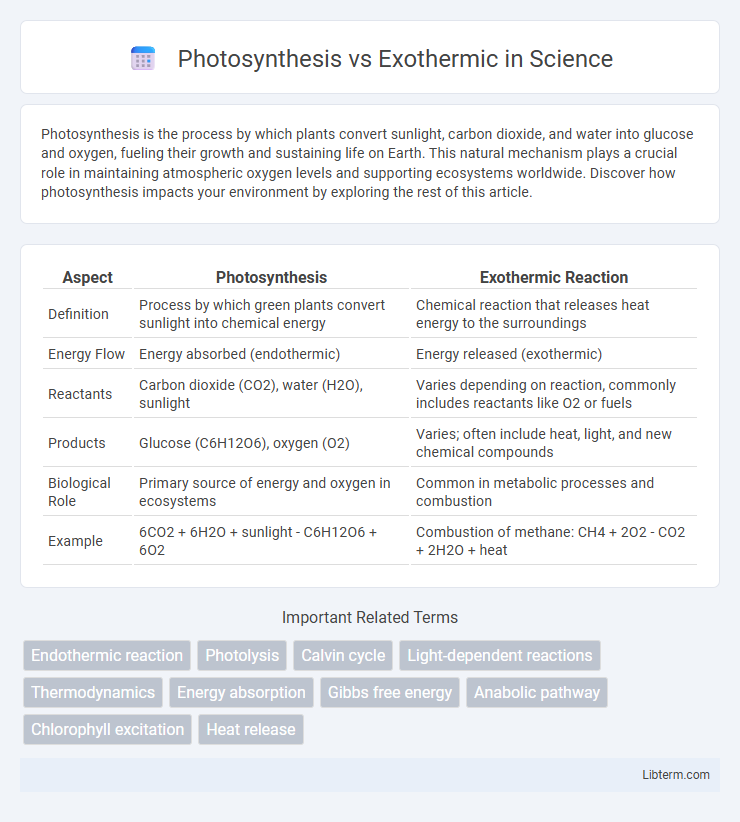Photosynthesis is the process by which plants convert sunlight, carbon dioxide, and water into glucose and oxygen, fueling their growth and sustaining life on Earth. This natural mechanism plays a crucial role in maintaining atmospheric oxygen levels and supporting ecosystems worldwide. Discover how photosynthesis impacts your environment by exploring the rest of this article.
Table of Comparison
| Aspect | Photosynthesis | Exothermic Reaction |
|---|---|---|
| Definition | Process by which green plants convert sunlight into chemical energy | Chemical reaction that releases heat energy to the surroundings |
| Energy Flow | Energy absorbed (endothermic) | Energy released (exothermic) |
| Reactants | Carbon dioxide (CO2), water (H2O), sunlight | Varies depending on reaction, commonly includes reactants like O2 or fuels |
| Products | Glucose (C6H12O6), oxygen (O2) | Varies; often include heat, light, and new chemical compounds |
| Biological Role | Primary source of energy and oxygen in ecosystems | Common in metabolic processes and combustion |
| Example | 6CO2 + 6H2O + sunlight - C6H12O6 + 6O2 | Combustion of methane: CH4 + 2O2 - CO2 + 2H2O + heat |
Introduction to Photosynthesis and Exothermic Processes
Photosynthesis is a biochemical process in which green plants, algae, and certain bacteria convert light energy into chemical energy by synthesizing glucose from carbon dioxide and water, releasing oxygen as a byproduct. Exothermic processes release energy, typically in the form of heat, during chemical reactions such as combustion or respiration. While photosynthesis is endothermic, absorbing energy to build complex molecules, exothermic reactions break down molecules, releasing stored energy into the surroundings.
Defining Photosynthesis: Nature’s Energy Converter
Photosynthesis is a biochemical process in plants, algae, and certain bacteria that converts light energy into chemical energy stored as glucose. This endothermic reaction absorbs sunlight, carbon dioxide, and water, producing oxygen as a byproduct. Unlike exothermic reactions that release energy, photosynthesis captures and stores solar energy, fueling growth and sustaining ecosystems.
Understanding Exothermic Reactions
Exothermic reactions release energy, primarily in the form of heat, as chemical bonds are formed and energy is given off to the surroundings. Photosynthesis, by contrast, is an endothermic process that absorbs energy from sunlight to convert carbon dioxide and water into glucose and oxygen. Understanding exothermic reactions involves analyzing energy changes where reactants have higher energy than products, causing excess energy to be emitted, critical in combustion and cellular respiration processes.
Key Differences: Photosynthesis vs Exothermic Reactions
Photosynthesis is an endothermic process that converts light energy into chemical energy stored in glucose, requiring carbon dioxide and water as reactants. Exothermic reactions release energy, usually as heat, to the surroundings, resulting in products with lower energy than the reactants. The key difference lies in energy flow: photosynthesis absorbs energy to build complex molecules, whereas exothermic reactions release energy by breaking chemical bonds.
Energy Flow: Absorption vs Release
Photosynthesis involves the absorption of solar energy to convert carbon dioxide and water into glucose and oxygen, storing energy in chemical bonds. Exothermic reactions release stored energy as heat or light when chemical bonds are broken during the transformation of reactants into products. This fundamental difference highlights energy flow: photosynthesis captures and stores energy, while exothermic processes discharge energy into the surroundings.
Chemical Equation Comparison
Photosynthesis involves the chemical equation 6CO2 + 6H2O + light energy - C6H12O6 + 6O2, representing the conversion of carbon dioxide and water into glucose and oxygen using sunlight. Exothermic reactions, such as combustion, typically follow equations like C6H12O6 + 6O2 - 6CO2 + 6H2O + energy, releasing energy by breaking down glucose. Comparing these, photosynthesis stores energy in chemical bonds, while exothermic reactions release energy by breaking those bonds.
Biological Importance of Photosynthesis
Photosynthesis is a crucial biological process that converts solar energy into chemical energy, producing glucose and oxygen essential for life on Earth. It sustains autotrophic organisms and forms the base of food chains, supporting heterotrophic life forms and maintaining atmospheric oxygen levels. In contrast, exothermic reactions release energy but do not contribute directly to energy capture or biomass production in ecosystems.
Industrial and Natural Examples of Exothermic Processes
Exothermic processes release heat as a byproduct, contrasting with photosynthesis, which stores energy in glucose molecules. Industrial examples of exothermic reactions include combustion in power plants and the crystallization of salts in chemical manufacturing. Natural exothermic processes encompass cellular respiration in living organisms and volcanic lava cooling.
Real-World Applications and Impacts
Photosynthesis drives sustainable agriculture by converting sunlight into chemical energy, supporting crop growth and carbon sequestration to mitigate climate change. Exothermic reactions power industries such as combustion engines and heating systems by releasing energy efficiently for mechanical work and thermal applications. Both processes impact energy management strategies, with photosynthesis offering renewable energy potential and exothermic reactions enabling rapid energy release in manufacturing and transportation sectors.
Summary: Comparing Photosynthesis and Exothermic Reactions
Photosynthesis is an endothermic process where plants absorb sunlight, carbon dioxide, and water to produce glucose and oxygen, storing energy chemically. Exothermic reactions release energy by breaking chemical bonds, often producing heat or light, such as combustion or respiration. Comparing both highlights energy flow direction: photosynthesis captures and stores energy, while exothermic reactions release it to the surroundings.
Photosynthesis Infographic

 libterm.com
libterm.com